This project is now in update mode. Check back regularly to see how things are progressing.
Genetic Testing as a Teaching Tool for Undergrads
Our Request: Support voluntary genetic ancestry testing for over 100 Cornell undergrads per year from disciplines across the University in the popular Personal Genomics and Medicine non‑majors course. Our goal is $8,500 to match funds provided by the University Courses Program at Cornell, which will allow us to offer the genetic testing at no cost to enrolled undergraduates. Students learn about their own genetic ancestry as a way to make classroom concepts about genetics and medicine personally meaningful and understandable. Student results also challenge them to think about the meaning of diversity and ancestry and to discuss these insights with their classmates, friends, and families at home. Students leave the course prepared to contribute meaningfully the growing dialogue of the societal, personal, ethical, legal and scientific challenges and opportunities that genetic testing, designer babies, and editing human genes presents.
Your support means that any student, any study, can participate.
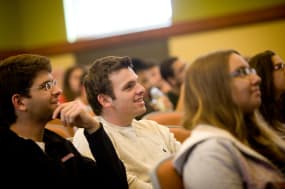
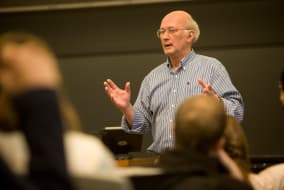
Above: Prof. Chip Aquadro teaching Personal Genomics and Medicine to non-majors
The Challenge, and Opportunity:
Every one of us should care about our genome. Knowing something about your genome can have a big impact on the quality of your life. Simple genetic variants cause more than half the world’s population to be unable to digest milk past the nursing age. Genetic testing is already a part of our world; all NCAA athletes – including 10 percent of Cornell students – are required to undergo genetic testing for sickle cell trait, a result of several training deaths being traced to the disease. Yet most of the public (including many undergraduates) does not understand basic genetics, the difference between absolute and relative risk of a disease, and how genetic ancestry can be inferred or related to disease risk. Too many are actually distrustful of scientific disciplines and/or their conclusions or predictions. How can we address this crisis in perception and understanding? One place to start is with our undergraduates.
A key challenge to the wise and expanded use of genetics in medicine is to enable informed engagement by individuals from many disciplines (not only biology/genetics, but also computer science, ethics, sociology, business management, government, economics, law, engineering, and other fields). I believe strongly that we can increase the pool of informed individuals in these disciplines by reaching these students early in their undergraduate schooling so that they may even explore the sciences further, and perhaps take courses in their own disciplines that would help them grapple with the relevant aspects from their disciplines of genetic testing implementation and wise use.
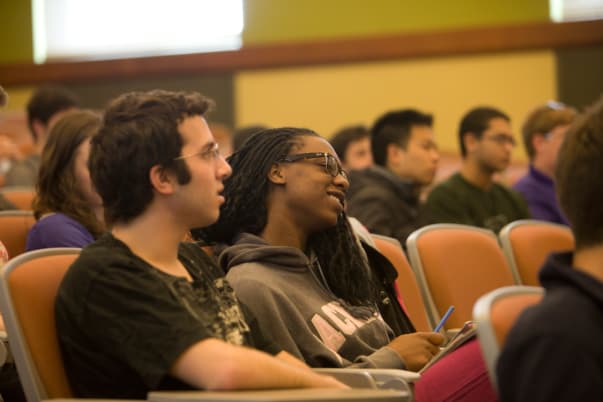
Above: Students engaged in learning their genetic ancestries as part of class.
“Many students share their class experience and results with their parents, siblings, relatives, as well as friends.“
The impact of such an effort magnifies on the classroom effort as students talk to their friends and family about the genetic principles underlying genetic ancestry inference, genetic testing of tumors and newborns, designer babies, and other related topics. By building training on the foundations everyone understands (we all have two biological parents, four grandparents, etc.), all of the fundamental principles of genetic ancestry inference, decent with modification (mutations on family trees), origins and spread of genetic disease, differences in prevalence among different populations, association mapping, and even the progression and mutational lineages associated with cancer can be taught in a manner that focuses first on intuitive concepts that may of the students already appreciate without bogging them down initially with all of the jargon.
Below: Example of genetic ancestry inference for two individuals with grandparents from four different continents. Also shown is the Genetic Ancestry percentages for students in the class spring 2016 emphasizing the remarkable ancestry diversity among Cornell students.
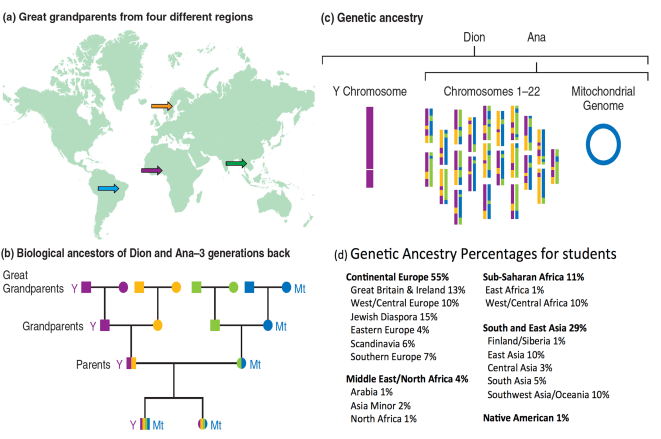
Professor Charles "Chip" Aquadro initiated an effort to address this challenge by launching the university-wide Cornell Genetic Ancestry Project in 2011. Genetic ancestry testing kits were provided (free) for 200 randomly chosen undergrads from across campus (plus local HS teachers), revealing their ancestry stories in a series of campus events and a documentary video. The success and broader impact of this event led Aquadro to develop in 2012 a full course on Personal Genomics and Medicine (BioMG1290) with two lectures and one discussion a week taught every spring semester to undergrads from over 20 diverse majors. The class has proven to be extremely popular.
Engaging more students means raising the enrollment cap for the class, currently imposed because of cost to provide genetic ancestry testing as part of the course. Hence this appeal for your support. Inclusion of genetic ancestry testing (offered to students at no cost) makes genetics “personal” to each student. It also substantially increases their motivation to learn genetic concepts, and to think deeply about informed consent. The course also challenge students to reflect on the conflicts that can emerge in reconciling personal views on diversity, race and ethics with sometimes very different views of their friends, classmates and family members. The focus is on genetic ancestry as a conscious effort to avoid revealing medical risk and carrier status to students. Aquadro provides all of his own genetic risk predictions to the students so they can see both the power, promise, but also the challenges in interpreting such information.
Your support means that any student, any study, can participate. Please help us reach our goal!
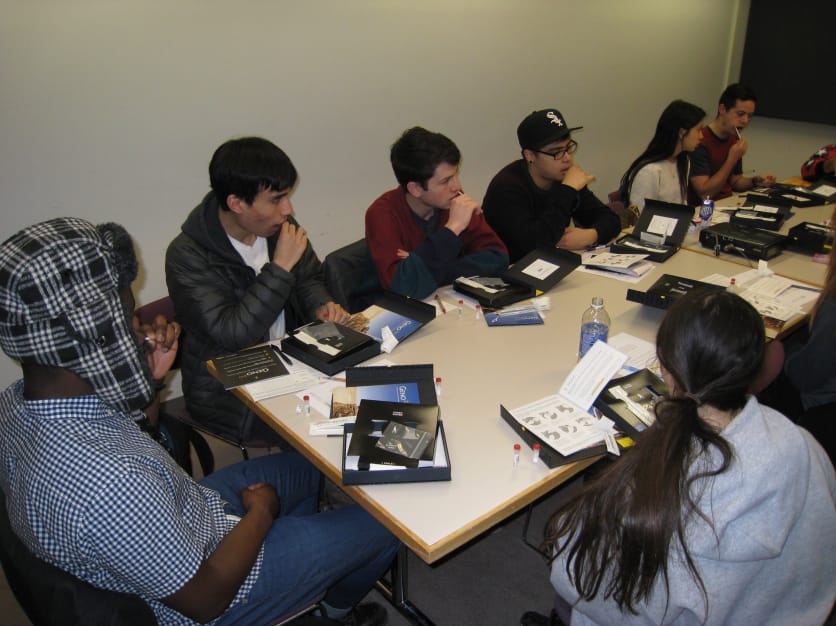
Pictures above & below: There's no way to not look silly swabbing your cheek to obtain cells for DNA isolation and genetic ancestry testing. (above): Undergraduate students swabbing their cheeks in discussion section at the beginning of the semester. Those who wish share their results with the rest of the class later in the semester. (below): Prof. Gerard Aching, then Director of the Africana Research Center, and University Provost Mike Kotlikoff participate in genetic ancestry testing and share their results and ancestry stories with the spring 2016 Personal Genomics and Medicine class.
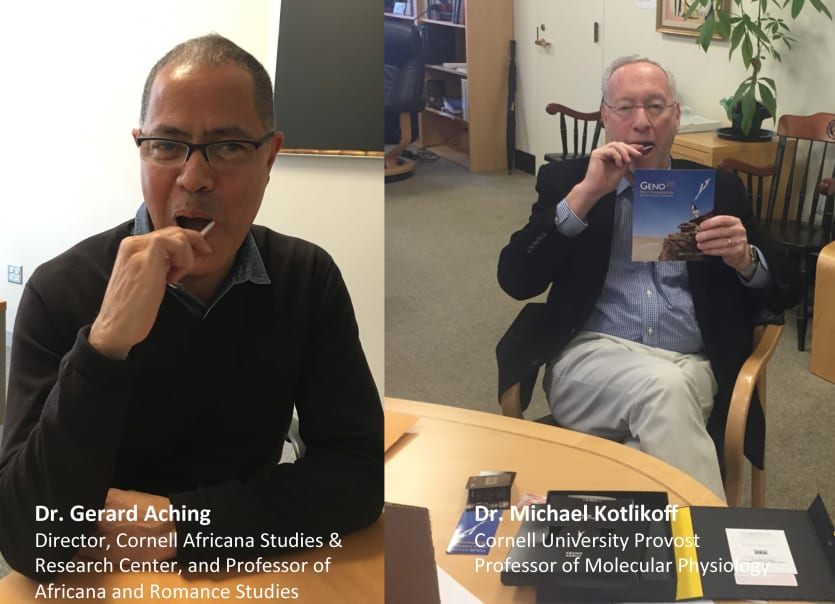
Learn more about the 2011 Cornell Genetic Ancestry Project:
http://3cpg.cornell.edu/index.cfm/page/AncestryProject.htm
Learn more about the Cornell Center for Comparative and Population Genomics (3CPG): http://3cpg.cornell.edu/
$25
Quarter of a genome
Purchases a quarter of an ancestry testing kit for a student in the class.
$50
Half a genome
purchases half of a genetic ancestry kit for a student in the class.
$75
Three quarters of a genome
Purchases three quarters of a genetic ancestry kit for a student in the class.
$1,000
Continent
Make a major impact on undergraduate students participating in Personal Genomics and Medicine by providing funding to purchase genetic ancestry kits for ten undergrads in the class.
$2,000
Benefactor
Become a major benefactor by providing support to make genetic ancestry testing available to twenty students enrolled in the class, and allowing the expansion of enrollment to engage even more students this year and next.


